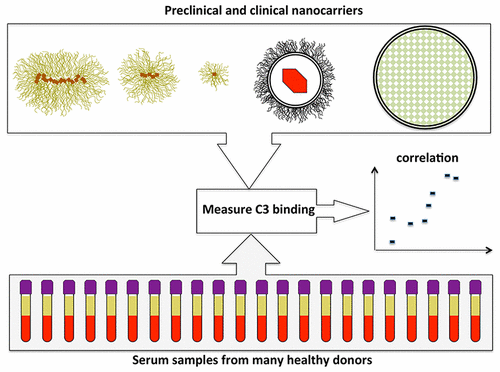当前位置:
X-MOL 学术
›
Bioconjugate Chem.
›
论文详情
Our official English website, www.x-mol.net, welcomes your
feedback! (Note: you will need to create a separate account there.)
Variability of Complement Response toward Preclinical and Clinical Nanocarriers in the General Population
Bioconjugate Chemistry ( IF 4.0 ) Pub Date : 2017-11-01 00:00:00 , DOI: 10.1021/acs.bioconjchem.7b00496 Halli Benasutti 1 , Guankui Wang 1 , Vivian P. Vu 1 , Robert Scheinman 1 , Ernest Groman 1 , Laura Saba 1 , Dmitri Simberg 1
Bioconjugate Chemistry ( IF 4.0 ) Pub Date : 2017-11-01 00:00:00 , DOI: 10.1021/acs.bioconjchem.7b00496 Halli Benasutti 1 , Guankui Wang 1 , Vivian P. Vu 1 , Robert Scheinman 1 , Ernest Groman 1 , Laura Saba 1 , Dmitri Simberg 1
Affiliation

|
Opsonization (coating) of nanoparticles with complement C3 component is an important mechanism that triggers immune clearance and downstream anaphylactic and proinflammatory responses. The variability of complement C3 binding to nanoparticles in the general population has not been studied. We examined complement C3 binding to dextran superparamagnetic iron oxide nanoparticles (superparamagnetic iron oxide nanoworms, SPIO NWs, 58 and 110 nm) and clinically approved nanoparticles (carboxymethyl dextran iron oxide ferumoxytol (Feraheme, 28 nm), highly PEGylated liposomal doxorubicin (LipoDox, 88 nm), and minimally PEGylated liposomal irinotecan (Onivyde, 120 nm)) in sera from healthy human individuals. SPIO NWs had the highest variation in C3 binding (n = 47) between subjects, with a 15–30 fold range in levels of C3. LipoDox (n = 12) and Feraheme (n = 18) had the lowest levels of variation between subjects (an approximately 1.5-fold range), whereas Onivyde (n = 18) had intermediate between-subject variation (2-fold range). There was no statistical difference between males and females and no correlation with age. There was a significant correlation in complement response between small and large SPIO NWs, which are similar structurally and chemically, but the correlations between SPIO NWs and other types of nanoparticles, and between LipoDox and Onivyde, were not significant. The calculated average number of C3 molecules bound per nanoparticle correlated with the hydrodynamic diameter but was decreased in LipoDox, likely due to the PEG coating. The conclusions of this study are (1) all nanoparticles show variability of C3 opsonization in the general population; (2) an individual’s response toward one nanoparticle cannot be reliably predicted based on another nanoparticle; and (3) the average number of C3 molecules per nanoparticle depends on size and surface coating. These results provide new strategies to improve nanomedicine safety.
中文翻译:

普通人群对临床前和临床纳米载体的补体反应的变异性
具有补体C3成分的纳米粒子的调理作用(涂层)是触发免疫清除以及下游的过敏性和促炎性反应的重要机制。尚未研究一般人群中补体C3与纳米颗粒结合的变异性。我们检查了补体C3与葡聚糖超顺磁性氧化铁纳米颗粒(超顺磁性氧化铁纳米蠕虫,SPIO NWs,58和110 nm)和临床认可的纳米颗粒(羧甲基葡聚糖氧化铁阿魏酸(Feraheme,28 nm),高度聚乙二醇化的脂质体阿霉素(LipoDox,88) nm),以及健康人血清中的最低PEG化脂质体伊立替康脂质体(Onivyde,120 nm)。SPIO NW的C3结合变化最大(n= 47),受试者之间的C3水平范围为15–30倍。LipoDox(n = 12)和Feraheme(n = 18)在受试者之间的变异水平最低(约1.5倍范围),而Onivyde(n= 18)的受试者间差异介于中间(2倍范围)。男女之间无统计学差异,与年龄也无相关性。小型和大型SPIO NW之间的补体响应之间存在显着相关性,在结构和化学上相似,但是SPIO NW与其他类型的纳米颗粒之间以及LipoDox和Onivyde之间的相关性不显着。计算出的每个纳米粒子结合的C3分子的平均数量与流体动力学直径相关,但在LipoDox中有所降低,这可能是由于PEG涂层所致。这项研究的结论是:(1)所有纳米粒子在一般人群中均表现出C3调理作用的变异性;(2)不能基于另一纳米粒子可靠地预测个人对一个纳米粒子的反应;(3)每个纳米粒子的平均C3分子数量取决于大小和表面涂层。这些结果提供了改善纳米药物安全性的新策略。
更新日期:2017-11-01
中文翻译:

普通人群对临床前和临床纳米载体的补体反应的变异性
具有补体C3成分的纳米粒子的调理作用(涂层)是触发免疫清除以及下游的过敏性和促炎性反应的重要机制。尚未研究一般人群中补体C3与纳米颗粒结合的变异性。我们检查了补体C3与葡聚糖超顺磁性氧化铁纳米颗粒(超顺磁性氧化铁纳米蠕虫,SPIO NWs,58和110 nm)和临床认可的纳米颗粒(羧甲基葡聚糖氧化铁阿魏酸(Feraheme,28 nm),高度聚乙二醇化的脂质体阿霉素(LipoDox,88) nm),以及健康人血清中的最低PEG化脂质体伊立替康脂质体(Onivyde,120 nm)。SPIO NW的C3结合变化最大(n= 47),受试者之间的C3水平范围为15–30倍。LipoDox(n = 12)和Feraheme(n = 18)在受试者之间的变异水平最低(约1.5倍范围),而Onivyde(n= 18)的受试者间差异介于中间(2倍范围)。男女之间无统计学差异,与年龄也无相关性。小型和大型SPIO NW之间的补体响应之间存在显着相关性,在结构和化学上相似,但是SPIO NW与其他类型的纳米颗粒之间以及LipoDox和Onivyde之间的相关性不显着。计算出的每个纳米粒子结合的C3分子的平均数量与流体动力学直径相关,但在LipoDox中有所降低,这可能是由于PEG涂层所致。这项研究的结论是:(1)所有纳米粒子在一般人群中均表现出C3调理作用的变异性;(2)不能基于另一纳米粒子可靠地预测个人对一个纳米粒子的反应;(3)每个纳米粒子的平均C3分子数量取决于大小和表面涂层。这些结果提供了改善纳米药物安全性的新策略。











































 京公网安备 11010802027423号
京公网安备 11010802027423号